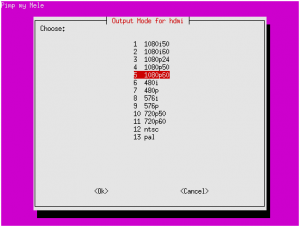PmM is the name of a configuration for Mele.
Made in perl/dialog.
It is currently a part of the lastest ubuntu/debian image made available here:
mele-ubuntu-12-10-armhf-base-with-nand-install-v1
mele-debian-wheezy-armhf-base-with-nand-install-v1
You can download it separately:
pimpmymele-0.1.tgz
ddfd0be76ab4d29f11c581d7b4edc91f pimpmymele-0.1.tgz
The goal is quite simple: Ease the process of configuring graphics/mac address/nand install/led blink.
You can choose to:
- install on NAND the image and boot from it
- change the graphic mode with the menu
- change the mac address
- blink the led red/blue with timing after the boot (really crucial feature)
In dialog mode (terminal):




Thanks for your work!!. One question. Why doesn´t appear the graphic option in my mele with pimp my mele? I´ve flash it with debian in nand and everything was ok.
Thank you.
If it’s the debian you found here, it’s a headless version so it’s normal. This version aim to get you the maximum ram available for networking and I/O.
PmM activates GFX selector only if a /dev/mali exists (which means the mali driver is loaded).
If you need Xorg and Mali, i have release here an ubuntu with gfx support.
Bye.
Guillaume! I have bricked my device! I did, by hand, the steps in the MMC_to_NAND.sh. I have my own kernel and rootfs, and I wanted to burn it on the nand… But now the problem is that the device is showing:
NAND read: Can not find partition ‘boot’
boota: bad boot image magic, maybe not a boot.img?
what u-boot params are you using?
Also, as an aside-> is your server farm doing ok? no signs of wear and tear on the flash?
It’s not bricked.
You should be able to boot from the SDCARD and repartition with nand-part.
Or you can reinstall android like explained here (http://www.cnx-software.com/2012/06/18/mele-a1000a2000-android-4-0-image-released/)
and follow the nand install from PimpMyMele.
For the cluster, so far so good:
$ uptime
10:08:13 up 65 days, 16:05, 1 user, load average: 0.40, 0.31, 0.32
The nand seems good, no failure yet. It’s just too slow to administrate, i regret to not have put my system partition on the ssd directly 😉
I made the changes to the A10’s nand driver and wrote the nand-part utility (originally posted on the miniand.com forums).
This version of PMM has a problem with the u-boot.bin not having the correct boot command string. I made changes to the lychee u-boot that fixed this (and uploaded it to http://dl.miniand.com/patwood/u-boot.bin); if you’re building your own, you should pull down the modified sun4i.h header from http://dl.miniand.com/patwood/sun4i.h (for 1G boards, change PHYS_SDRAM_1_SIZE to (1024 << 20)).
Hello guillaume,
I’ve been reading your article and testing on my cubieboard.
Both your ubuntu and debian imgs work successfully on cubieboard’s nand.
Yet my DVI+HDCP monitor couldn’t get any signal from cubieboard(as well as the andriod imgs)
So far, I’ve been trying all graphic settings on Pimp my Mele.
Also I tried to edit script.bin or added uEnv.txt from someone else’s DVI layout solutions, but still nothing changed
The monitor I use
http://www.gechic.com/product_help_en.asp?s=3
Except berryboot img. Which works pretty well but it doesn’t support nand installation.
My question is, is it possible to use Pimp my Mele on berryboot SDcard and how.
Or did I missing something to convert the hdmi signal.
Thank you.
Nice screen 😉
If you plug it to hdmi, it should work.
I see it is powered by usb… Are you sure the board could manage it?
Perhaps you could try to power it from a desktop usb.
Thanks guilaume, didn’t notice you replied my post until now.
I’ve been trying to use different sources of USB power.
desktop, laptop, USB charger even portable battery.
but still it only respond to berryboot img.
it says on their website:
The On-Lap Monitor supports DVI signal through HDMI port. On-Lap Monitor can connect to laptop, iPhone/iPad or any electronics that provide DVI signal output and HDMI port to allow for expanded images and application use.
some say that A10 and android doesn’t really support DVI and VGA output.
but then it won’t explain why berryboot does the job.
so I am thinking it might be the kernel or A10 driver.
I tried to replace script.bin from bootberry img to your imgs but the outcome is still the same.
sorry I know it’s nothing reverent to your project.
but I was just hoping there could be a simply solution to it.
here are the screen shots of it.
http://postimg.org/image/n2olou3at/
http://postimg.org/image/lc5knclrp/
I’m not an expert of video stuff but as far as i know, hdmi signal is the same as dvi.
That’s why you can convert hdmi to dvi with a simple cable.
If you plug your cubieboard to a classic hdmi display (lcd, tv), is it working well ?
You should put your script.bin at hdmi-420p and try it.
If it’s working, perhaps your screen is not synchronizing with the live signal.
The hdmi is loading as module after the boot process. try to unplug the usb power and replug. try to unplug the hdmi and replug.
Try to mess with the module list (/etc/modules).
lcd
hdmi
ump
disp
mali
mali_drm
Comment them all and load them by hand with modprobe (keep the loading order).
You can avoid loading lcd.
it works fine on HDMI TV. but I haven’t get to test it on other lcd monitor due to I don’t have any HDMI -> DVI converter with me.
I will look into those modules you suggested
hopefully I can figure something out.
Thank you guliaume
Can’t install xterm using
apt-get install xterm …
Broken Packages Message.
apt-get update
apt-get install xterm
?